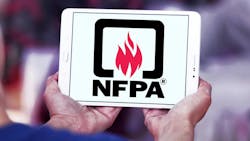The title of Annex R is “Working with Capacitors.” It is easily the largest of the Annexes, consisting of 10 pages covering R.1 through R.17. It covers a lot of ground. Here’s a quick overview.
The introduction explains why capacitors are dangerous (they can store electricity), even when equipped with bleed-off capacitors. Annex R provides detailed guidance on how to properly assess the risks and implement suitable controls.
Section 2 contains the “qualified person” rule. Section 3 provides a detailed explanation of the various electric shock hazards. Section 4 provides a detailed explanation of the various short-circuit hazards. Section 5 provides a detailed explanation of the hazards associated with internal rupture.
Section 6 explains how to perform a risk assessment for capacitors. This includes determining the arc flash and arc blast hazards. It also includes determining the discharge time and developing a written discharge procedure.
Section 7 explains how to determine the electric shock hazard, and section 8 explains how to determine the energy stored in the capacitor. Sections 9 and 10 provide the mathematical method for calculating the arc flash hazard and the arc blast hazard, respectively.
Section 11 explains how to select the appropriate test and grounding method. Among other things, it covers hard grounding and soft grounding and provides Figure R.11.9(a) to illustrate the difference. Table R.11.9 is helpful for selecting the most appropriate method.
Section 12 explains how to determine the capacitor discharge time. Section 13 explains how to establish an electrically safe work condition where capacitors are present. Section 14 covers the storage and disposal of capacitors. Section 15 provides solid advice on labeling.
Then we get to ground sticks, the subject of Section 16. These are designed, constructed, and installed to safely discharge capacitors. They should be tested periodically, and Section 16 provides recommendations. The selection of where they go and how they are connected requires some analysis, and Section 16 provides guidance on that.
Annex R closes with Section 17, which is a list of eight references.
About the Author

Mark Lamendola
Mark is an expert in maintenance management, having racked up an impressive track record during his time working in the field. He also has extensive knowledge of, and practical expertise with, the National Electrical Code (NEC). Through his consulting business, he provides articles and training materials on electrical topics, specializing in making difficult subjects easy to understand and focusing on the practical aspects of electrical work.
Prior to starting his own business, Mark served as the Technical Editor on EC&M for six years, worked three years in nuclear maintenance, six years as a contract project engineer/project manager, three years as a systems engineer, and three years in plant maintenance management.
Mark earned an AAS degree from Rock Valley College, a BSEET from Columbia Pacific University, and an MBA from Lake Erie College. He’s also completed several related certifications over the years and even was formerly licensed as a Master Electrician. He is a Senior Member of the IEEE and past Chairman of the Kansas City Chapters of both the IEEE and the IEEE Computer Society. Mark also served as the program director for, a board member of, and webmaster of, the Midwest Chapter of the 7x24 Exchange. He has also held memberships with the following organizations: NETA, NFPA, International Association of Webmasters, and Institute of Certified Professional Managers.
